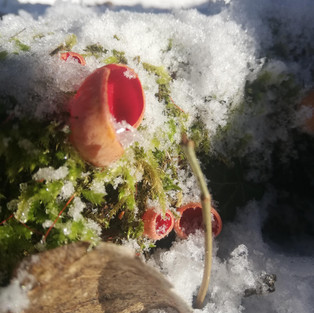Scarlet Elf Cup - Sarcoscypha Austriaca
- wildwoodlandlearning
- Feb 12, 2021
- 2 min read
This week's fungus is the beautiful and delicate scarlet elf cup, it's a real delight to find in the depths of winter. It's the fungus of faeries and folklore, used in ancient medicine for its healing properties. We'll have look at how, where and when to find this winter beauty.

Scarlet elf cup looks exactly as it sounds, a deep hollow bowl shape from which elves can drink morning dew or faeries can bathe. The inner surface of the bowl is deep red and the outer surface is orange. It has a close relative called the ruby elf cup fungus which is very similar, perhaps a little darker in colour. The red surface is where the spores are released from. Scarlet elf cup is an 'ascomycota' fungus which means it actively shoots its spores into the air. You can see this happening on a YouTube video here
Scarlet elf cups offer one of the best opportunities to observe this spore explosion: by blowing on them (ideally in March or April) you can trigger them to shoot clouds of spores which can be seen with the naked eye. This is not the movement of your breath raising a cloud, but the slight change in temperature that it brings triggering many thousands of spores into being expelled from the inner surface of the cup by a pump action. I'm looking forward to giving this a go in spring time, it also helps disperse the spores to enable more scarlet elf cup to grow.
We've talked about 'decomposer fungus' or saprophytes which eat dead wood and recycle it into nutrients which are released back into the earth to support new plant life. Scarlet elf cup is a saprophyte which lives on dead branches of deciduous trees such as hazel or sycamore which are decaying and normally covered in moss. It likes to grow in damp places, especially on the forest floor where it can attach itself to leaf litter or nestle into rotting mossy branches. You'll find it in shady, damp ditches and near river beds. Scarlet elf cup is found all over the UK, more often in areas with high rainfall, making Scotland a perfect home for it.
Many foragers use this fungus as it presents beautifully on the plate. Some say the fungus is inedible whilst others say it has an 'earthy' taste with a hint of beetroot! We encourage you to leave the elf cups where you see them, in their natural environment, doing their job for everyone to admire.
Until next week,
Happy fungi finding,
W.I.L.D.
















Comments